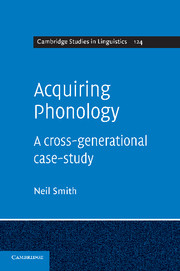2 - The main claims of Smith (1973) and the evidence for them
Published online by Cambridge University Press: 04 August 2010
Summary
Introduction
The analyses in APh were couched in the rule-based framework of classical (SPE) generative phonology. Its major claims came in two parts: first that, by the time he begins to speak, the child's lexical representations must be in terms of the adult surface forms of the target language and, second, that the child does not have his own phonological system. This is not to deny that “children play an active role in acquiring the phonology of their language” (Stoel-Gammon and Sosa, 2007: 250). Children differ in ways that go beyond differences in the input, so some contribution from them is clearly necessary. It is not obvious, however, that matters of lexical selection, regression, avoidance, and so on give rise to an idiosyncratic phonological system defining their competence. What is in part idiosyncratic is the set of performance strategies that each child exploits to circumvent the problems of production. A number of other claims followed, most notably that the child's developing perception must be at least adequate for him to discriminate and encode all the contrasts of the language being acquired. Illustrating and justifying these claims it was then suggested that the child's own pronunciations and mispronunciations are correctly characterised in terms of the application of an ordered set of ‘realisation rules’, supplemented by phonetic detail rules. These sets of rules take the adult form as input and give (a representation of) the child's productions as output.
- Type
- Chapter
- Information
- Acquiring PhonologyA Cross-Generational Case-Study, pp. 19 - 29Publisher: Cambridge University PressPrint publication year: 2009

